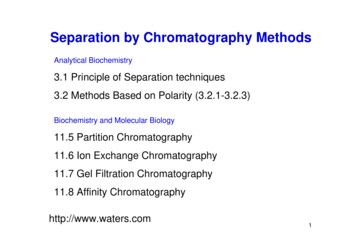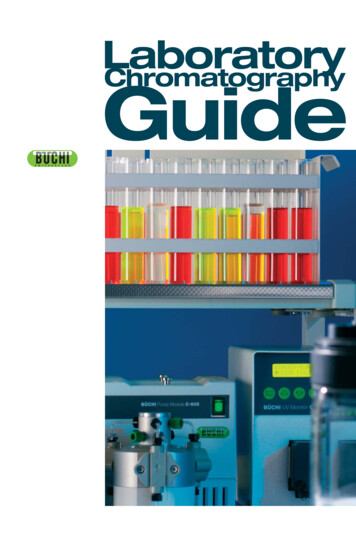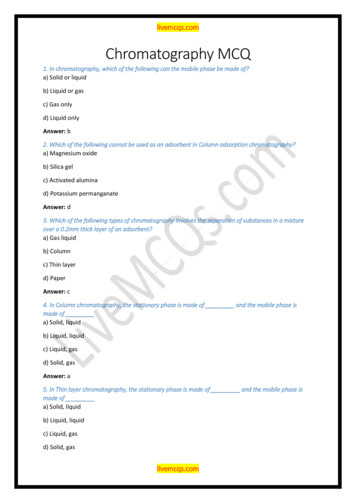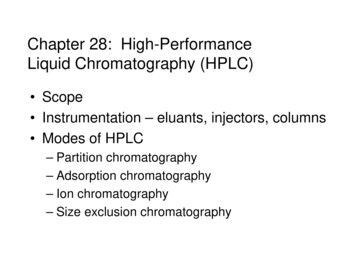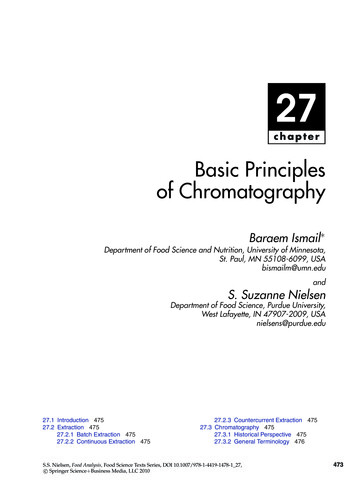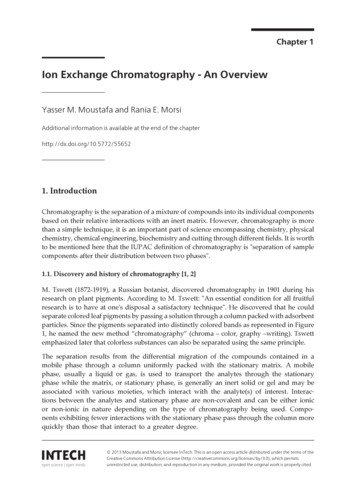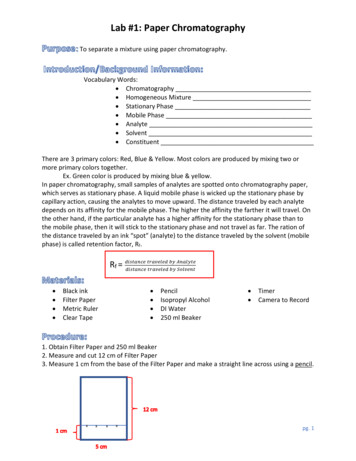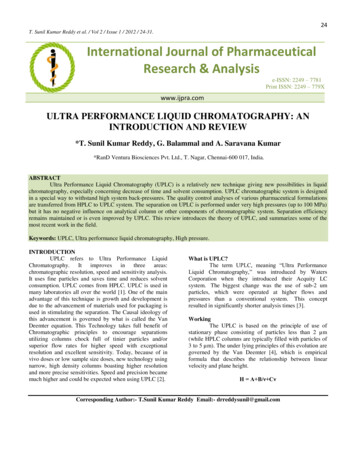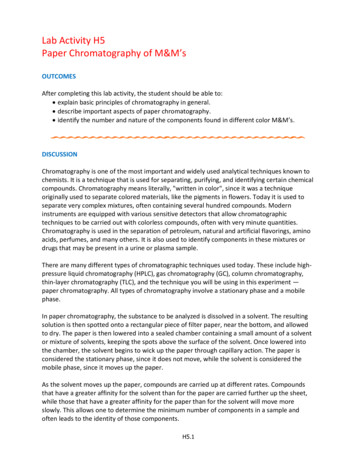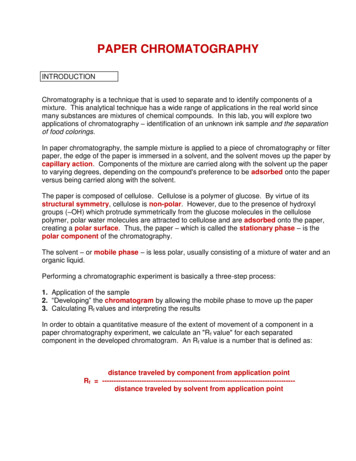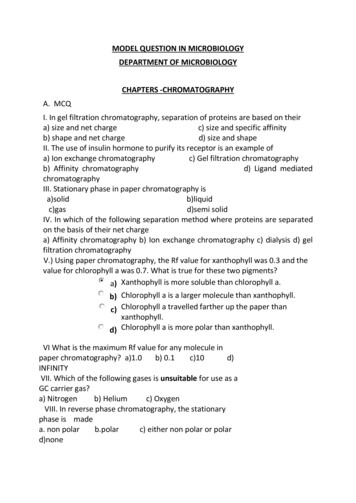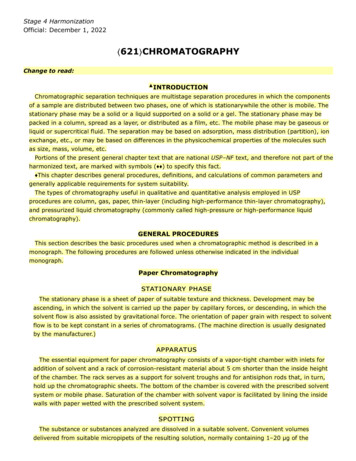
Transcription
Stage 4 HarmonizationOfficial: December 1, 2022〈621〉CHROMATOGRAPHYChange to read: INTRODUCTIONChromatographic separation techniques are multistage separation procedures in which the componentsof a sample are distributed between two phases, one of which is stationarywhile the other is mobile. Thestationary phase may be a solid or a liquid supported on a solid or a gel. The stationary phase may bepacked in a column, spread as a layer, or distributed as a film, etc. The mobile phase may be gaseous orliquid or supercritical fluid. The separation may be based on adsorption, mass distribution (partition), ionexchange, etc., or may be based on differences in the physicochemical properties of the molecules suchas size, mass, volume, etc.Portions of the present general chapter text that are national USP–NF text, and therefore not part of theharmonized text, are marked with symbols ( ) to specify this fact. This chapter describes general procedures, definitions, and calculations of common parameters andgenerally applicable requirements for system suitability.The types of chromatography useful in qualitative and quantitative analysis employed in USPprocedures are column, gas, paper, thin-layer (including high-performance thin-layer chromatography),and pressurized liquid chromatography (commonly called high-pressure or high-performance liquidchromatography).GENERAL PROCEDURESThis section describes the basic procedures used when a chromatographic method is described in amonograph. The following procedures are followed unless otherwise indicated in the individualmonograph.Paper Chromatographystationary phaseThe stationary phase is a sheet of paper of suitable texture and thickness. Development may beascending, in which the solvent is carried up the paper by capillary forces, or descending, in which thesolvent flow is also assisted by gravitational force. The orientation of paper grain with respect to solventflow is to be kept constant in a series of chromatograms. (The machine direction is usually designatedby the manufacturer.)apparatusThe essential equipment for paper chromatography consists of a vapor-tight chamber with inlets foraddition of solvent and a rack of corrosion-resistant material about 5 cm shorter than the inside heightof the chamber. The rack serves as a support for solvent troughs and for antisiphon rods that, in turn,hold up the chromatographic sheets. The bottom of the chamber is covered with the prescribed solventsystem or mobile phase. Saturation of the chamber with solvent vapor is facilitated by lining the insidewalls with paper wetted with the prescribed solvent system.spottingThe substance or substances analyzed are dissolved in a suitable solvent. Convenient volumesdelivered from suitable micropipets of the resulting solution, normally containing 1–20 µg of the
compound, are placed in 6- to 10-mm spots not less than 3 cm apart.descending paper chromatography procedure1. A spotted chromatographic sheet is suspended in the apparatus, using the antisiphon rod to holdthe upper end of the sheet in the solvent trough. [Note—Ensure that the portion of the sheethanging below the rods is freely suspended in the chamber without touching the rack, thechamber walls, or the fluid in the chamber.]2. The chamber is sealed to allow equilibration (saturation) of the chamber and the paper with thesolvent vapor. Any excess pressure is released as necessary.3. After equilibration of the chamber, the prepared mobile phase is introduced into the troughthrough the inlet.4. The inlet is closed, and the mobile solvent phase is allowed to travel the desired distance downthe paper.5. The sheet is removed from the chamber.6. The location of the solvent front is quickly marked, and the sheet is dried.7. The chromatogram is observed and measured directly or after suitable development to reveal thelocation of the spots of the isolated drug or drugs.ascending paper chromatography procedure1. The mobile phase is added to the bottom of the chamber.2. The chamber is sealed to allow equilibration (saturation) of the chamber and the paper with thesolvent vapor. Any excess pressure is released as necessary.3. The lower edge of the stationary phase is dipped into the mobile phase to permit the mobile phaseto rise on the chromatographic sheet by capillary action.4. When the solvent front has reached the desired height, the chamber is opened, the sheet isremoved, the location of the solvent front is quickly marked, and the sheet is dried.5. The chromatogram is observed and measured directly or after suitable development to reveal thelocation of the spots of the isolated drug or drugs.Thin-Layer Chromatographystationary phaseThe stationary phase is a relatively thin, uniform layer of dry, finely powdered material applied to aglass, plastic, or metal sheet or plate (typically called the plate). The stationary phase of thin-layerchromatography (TLC) plates has an average particle size of 10–15 µm, and that of high-performanceTLC (HPTLC) plates has an average particle size of 5 µm. Commercial plates with a preadsorbent zonecan be used if they are specified in a monograph. Sample applied to the preadsorbent region developsinto sharp, narrow bands at the preadsorbent–sorbent interface. The separations achieved may bebased on adsorption, partition, or a combination of both effects, depending on the particular type ofstationary phase.apparatusA chromatographic chamber made of inert, transparent material and having the followingspecifications is used: a flat-bottom or twin trough, a tightly fitted lid, and a size suitable for the plates.The chamber is lined on at least one wall with filter paper. Sufficient mobile phase or developing solventis added to the chamber so that, after impregnation of the filter paper, a depth appropriate to thedimensions of the plate used is available. The chromatographic chamber is closed and allowed to
equilibrate. [Note—Unless otherwise indicated, the chromatographic separations are performed in asaturated chamber.]detection/visualizationAn ultraviolet (UV) light source suitable for observations under short- (254 nm) and long- (365 nm)wavelength UV light and a variety of spray reagentsto make spots visibleare often used.spottingSolutions are spotted on the surface of the stationary phase (plate) at the prescribed volume insufficiently small portions to obtain circular spots of 2–5 mm in diameter (1–2 mm on HPTLC plates) orbands of 10–20 mm 1–2 mm (5–10 mm 0.5–1 mm on HPTLC plates) at an appropriate distancefrom the lower edge and sides of the plate. [Note—During development, the application position mustbe at least 5 mm (TLC) or 3 mm (HPTLC) above the level of the mobile phase.] The solutions areapplied on a line parallel to the lower edge of the plate with an interval of at least 10 mm (5 mm onHPTLC plates) between the centers of spots, or 4 mm (2 mm on HPTLC plates) between the edges ofbands, then allowed to dry.procedure1. Place the plate in the chamber, ensuring that the spots or bands are above the surface of themobile phase.2. Close the chamber.3. Allow the mobile phase to ascend the plate until the solvent front has traveled three-quarters ofthe length of the plate, or the distance prescribed in the monograph.4. Remove the plate, mark the solvent front with a pencil, and allow to dry.5. Visualize the chromatograms as prescribed.6. Determine the chromatographic retardation factor (RF) values for the principal spots or zones.7. Presumptive identification can be made by observation of spots or zones of identical RF value andabout equal magnitude obtained, respectively, with an unknown and a standard chromatographedon the same plate. A visual comparison of the size or intensity of the spots or zones may serve forsemiquantitative estimation. Quantitative measurements are possible by means of densitometry(absorbance or fluorescence measurements).Column Chromatographysolid supportPurified siliceous earth is used for normal-phase separation. Silanized chromatographic siliceous earthis used for reverse-phase partition chromatography.stationary phaseThe solid support is modified by the addition of a stationary phase specified in the individualmonograph. If a mixture of liquids is used as the stationary phase, mix the liquids before theintroduction of the solid support.mobile phaseThe mobile phase is specified in the individual monograph. If the stationary phase is an aqueoussolution, equilibrate with water. If the stationary phase is a polar organic fluid, equilibrate with thatfluid.
apparatusUnless otherwise specified in the individual monograph, the chromatographic tube is about 22 mm ininside diameter and 200–300 mm in length. Attached to it is a delivery tube, without stopcock, about 4mm in inside diameter and about 50 mm in length.Apparatus preparation: Pack a pledget of fine glass wool in the base of the tube. Combine thespecified volume of stationary phase and the specified amount of solid support to produce ahomogeneous, fluffy mixture. Transfer this mixture to the chromatographic tube, and tamp using gentlepressure to obtain a uniform mass. If the specified amount of solid support is more than 3 g, transferthe mixture to the column in portions of approximately 2 g, and tamp each portion. If the assay or testrequires a multisegment column with a different stationary phase specified for each segment, tampafter the addition of each segment, and add each succeeding segment directly to the previous one.Pack a pledget of fine glass wool above the completed column packing. [Note—The mobile phaseshould flow through a properly packed column as a moderate stream or, if reverse-phasechromatography is applied, as a slow trickle.]If a solution of the analyte is incorporated into the stationary phase, complete the quantitativetransfer to the chromatographic tube by scrubbing the beaker used for the preparation of the testmixture with a mixture of about 1 g of solid support and several drops of the solvent used to preparethe sample solution before adding the final portion of glass wool.procedure1. Transfer the mobile phase to the column space above the column packing, and allow it to flowthrough the column under the influence of gravity.2. Rinse the tip of the chromatographic column with about 1 mL of mobile phase before each changein composition of mobile phase and after completion of the elution.3. If the analyte is introduced into the column as a solution in the mobile phase, allow it to passcompletely into the column packing, then add mobile phase in several small portions, allowingeach to drain completely, before adding the bulk of the mobile phase.4. Where the procedure indicates the use of multiple chromatographic columns mounted in seriesand the addition of mobile phase in divided portions is specified, allow each portion to draincompletely through each column, and rinse the tip of each with mobile phase before the additionof each succeeding portion.Gas Chromatography (GC)liquid stationary phaseThis type of phase is available in packed or capillary columns.packed column GCThe liquid stationary phase is deposited on a finely divided, inert solid support, such as diatomaceousearth, porous polymer, or graphitized carbon, which is packed into a column that is typically 2–4 mm ininternal diameter and 1–3 m in length.capillary column GCIn capillary columns, which contain no packed solid support, the liquid stationary phase is depositedon the inner surface of the column and may be chemically bonded to it.solid stationary phase
This type of phase is available only in packed columns. In these columns the solid phase is an activeadsorbent, such as alumina, silica, or carbon, packed into a column. Polyaromatic porous resins, whichare sometimes used in packed columns, are not coated with a liquid phase. [Note—Packed and capillarycolumns must be conditioned before use until the baseline and other characteristics are stable. Thecolumn or packing material supplier provides instructions for the recommended conditioning procedure.]apparatusA gas chromatograph consists of a carrier gas source, injection port, column, detector, and recordingdevice. The injection port, column, and detector are temperature controlled and may be varied as partof the analysis. The typical carrier gas is helium, nitrogen, or hydrogen, depending on the column anddetector in use. The type of detector used depends on the nature of the compounds analyzed and isspecified in the individual monograph. Detector output is recorded as a function of time, and theinstrument response, measured as peak area or peak height, is a function of the amount present.temperature programThe length and quality of a GC separation can be controlled by altering the temperature of thechromatographic column. When a temperature program is necessary, the individual monographindicates the conditions in table format. The table indicates the initial temperature, rate of temperaturechange (ramp), final temperature, and hold time at the final temperature.procedure1. Equilibrate the column, injector, and detector with flowing carrier gas until a constant signal isreceived.2. Inject a sample through the injector septum, or use an autosampler.3. Begin the temperature program.4. Record the chromatogram.5. Analyze as indicated in the monograph.Liquid ChromatographyThe term "liquid chromatography" (LC), as used in the compendia, is synonymous with high-pressureliquid chromatography and high-performance liquid chromatography. LC is a separation technique basedon a solid stationary phase and a liquid mobile phase.stationary phaseSeparations are achieved by partition, adsorption, or ion-exchange processes, depending on the typeof stationary phase used. The most commonly used stationary phases are modified silica or polymericbeads. The beads are modified by the addition of long-chain hydrocarbons. The specific type of packingneeded to complete an analysis is indicated by the “L” designation in the individual monograph (see alsothe section Chromatographic Columns). The size of the beads is often described in the monograph aswell. Changes in the packing type and size are covered in the System Suitability section of this chapter.chromatographic columnThe term "column" includes stainless steel, lined stainless steel, and polymeric columns, packed witha stationary phase. The length and inner diameter of the column affects the separation, and thereforetypical column dimensions are included in the individual monograph. Changes to column dimensions arediscussed in the System Suitability section of this chapter. Compendial monographs do not include thename of appropriate columns; this omission avoids the appearance of endorsement of a vendor’s
product and natural changes in the marketplace. See the section Chromatographic Columns for moreinformation.In LC procedures, a guard column may be used with the following requirements, unless otherwise isindicated in the individual monograph: (a) the length of the guard column must be NMT 15% of thelength of the analytical column, (b) the inner diameter must be the same or smaller than that of theanalytical column, and (c) the packing material should be the same as the analytical column (e.g.,silica) and contain the same bonded phase (e.g., C18). In any case, all system suitability requirementsspecified in the official procedure must be met with the guard column installed.mobile phaseThe mobile phase is a solvent or a mixture of solvents, as defined in the individual monograph.apparatusA liquid chromatograph consists of a reservoir containing the mobile phase, a pump to force themobile phase through the system at high pressure, an injector to introduce the sample into the mobilephase, a chromatographic column, a detector, and a data collection device.gradient elutionThe technique of continuously changing the solvent composition during the chromatographic run iscalled gradient elution or solvent programming. The gradient elution profile is presented in the individualmonograph as a gradient table, which lists the time and proportional composition of the mobile phase atthe stated time.procedure1. Equilibrate the column and detector with mobile phase at the specified flow rate until a constantsignal is received.2. Inject a sample through the injector, or use an autosampler.3. Begin the gradient program.4. Record the chromatogram.5. Analyze as directed in the monograph.CHROMATOGRAPHIC COLUMNSA complete list of packings (L), phases (G), and supports (S) used in USP–NF tests and assays islocated in USP–NF, Reagents, Indicators, and Solutions—Chromatographic Columns. This list is intendedto be a convenient reference for the chromatographer in identifying the pertinent chromatographiccolumn specified in the individual monograph. DEFINITIONSThe system suitability and acceptance criteria in monographs have been set using parameters asdefined below. With some equipment, certain parameters, such as the signal-to-noise ratio andresolution, can be calculated using software provided by the manufacturer. It is the responsibility of theuser to ensure that the calculation methods used in the software are equivalent to the requirements ofthe US Pharmacopeiaand to make any necessary corrections if this is not the case.Chromatogram: A graphical or other representation of detector response, effluent concentration, orother quantity used as a measure of effluent concentration versus time or volume. Idealizedchromatograms are represented as a sequence of Gaussian peaks on a baseline (Figure 1).
Click image to enlargeFigure 1.VM hold-up volumetM hold-up timeVR1 retention volume of peak 1tR1 retention time of peak 1VR2 retention volume of peak 2tR2 retention time of peak 2Wh peak width at half-heightWi peak width at the inflection pointh height of the peakh/2 half-height of peakDistribution constant (K0): In size-exclusion chromatography, the elution characteristics of acomponent in a particular column may be given by the distribution constant (also referred to as distributioncoefficient), which is calculated using the following equation:K0 tR t0tt t0tR retention timet0 retention time of an unretained compoundtt total mobile phase timeDwell volume (D) (also referred to as VD): The dwell volume (also known as gradient delayvolume) is the volume between the point at which the eluents meet and the inlet of the column. It can bedetermined using the following procedure.
column: Replace the chromatographic column by an appropriate capillary tubing (e.g., 1 m 0.12mm).mobile phase: See Table 1.mobile phase A: Watermobile phase B: 0.1% v/v solution of acetone in waterTable 1Time(min)Mobile phase A(% v/v)Mobile phase B(% v/v)0–20100 00 10020–300100flow rate: Set to obtain sufficient back-pressure (e.g., 2 mL/min).detection: Spectrophotometer at 265 nmDetermine the time (t0.5), in minutes, when the absorbance has increased by 50% (Figure 2).D tD FtD t0.5 — 0.5tG (min)tG pre-defined gradient time, 20 minF flow rate (mL/min)Click image to enlargeFigure 2.[Note—where applicable, this measurement is performed with the autosampler in the "inject" positionso as to include the injection loop volume in the dwell volume.]
Hold-up time (tM): Time required for elution of an unretained component (see Figure 1, baseline scalebeing in minutes or seconds).In size-exclusion chromatography, the term retention time of an unretained compound (t0) is used.Hold-up volume (VM): Volume of the mobile phase required for elution of an unretained component. Itmay be calculated from the hold-up time and the flow rate (F) in milliliters per minute using the followingequation:VM tM FIn size-exclusion chromatography, the term "retention volume" of an unretained compound V0 is used.Peak: Portion of a chromatogram recording the detector response when a single component (or two ormore unresolved components) is eluted from the column.The peak response may be represented by the peak area or the peak height (h).Peak-to-Valley Ratio (p/v): The peak-to-valley ratio may be employed as a system suitability criterionwhen baseline separation between two peaks is not achieved (see Figure 3).Click image to enlargeFigure 3.
p/v HpHvHp height above the extrapolated baseline of the minor peakHv height above the extrapolated baseline at the lowest point of the curve separating the minor andmajor peaksPlate height (H) (height equivalent to one theoretical plate [HETP]): Ratio of the columnlength (L), in micrometers, to the plate number (N):H LNPlate number (N) (number of theoretical plates): A number indicative of column performance(column efficiency) can only be calculated from data obtained under either isothermal, isocratic, or isodenseconditions, depending on the technique, as the plate number, using the following equation, the values of tRand Wh being expressed in the same units:N 5.54 (tRWh2)tR retention time of the peak corresponding to the componentWh peak width at half-height (h/2)The plate number varies with the component as well as with the column, the column temperature, themobile phase, and the retention time.Reduced plate height (h): Ratio of the plate height (H), in micrometers, to the particle diameter (dp) inmicrometers:h HdpRelative retardation (Rrel): The relative retardation, used in thin-layer chromatography, is calculatedas the ratio of the distances travelled by the spot of the compound of interest and a reference compound(Figure 4).
Click image to enlargeFigure 4.R r el b/ca migration distance of the mobile phaseb migration distance of the compound of interestc migration distance of the reference compoundRelative retention (r): Relative retention is calculated as an estimate using the following equation:r tRi tMtRst tMtRi retention time of the peak of interesttRst retention time of the reference peak (usually the peak corresponding to the substance to betM hold-up timeexamined)Relative retention, unadjusted (rG) or (RRT) The unadjusted relative retention is calculated using the following equation:rG tRitRstUnless otherwise indicated, values for relative retention stated in monographs correspond to unadjustedrelative retention. Relative retention time (RRT): See Relative retention, unadjusted
Resolution (Rs): The resolution between peaks of two components (Figure 1) may be calculated usingthe following equation:RS 1.18(tR2 tR1 )Wh1 Wh2tR 2 tR 1tR1, tR2 retention times of the peaksWh1, Wh2 peak widths at half-heightIn quantitative thin-layer chromatography, using densitometry, the migration distances are used insteadof retention times and the resolution between peaks of two components may be calculated using thefollowing equation:RS 1.18a(RF 2 RF 1 )Wh1 Wh2RF 2 RF 1RF1, RF2 retardation factors of the peaksWh1, Wh2 peak widths at half-heighta migration distance of the solvent frontRetardation factor (RF): The retardation factor, used in thin-layer chromatography, is the ratio of thedistance from the point of application to the center of the spot and the distance simultaneously travelled bythe solvent front from the point of application (Figure 4).RF b migration distance of the componenta migration distance of the solvent frontbaRetention factor (k): The retention factor (also known as mass distribution ratio (Dm) or capacity factor(k′)) is defined as:k amount of c omponent i n s t at i onar y phas eamount of c omponent i n mobi l e phas e KcVSVMKC distribution constant (also known as equilibrium distribution coefficient)VS volume of the stationary phaseVMvolume of the mobile phaseThe retention factor of a component may be determined from the chromatogram using the followingequation:k tR retention timetM hold-up timetR tMtMRetention time (tR): Time elapsed between the injection of the sample and the appearance of themaximum peak response of the eluted sample zone (Figure 1, baseline scale being in minutes or seconds).Retention volume (VR):
Volume of the mobile phase required for elution of a component. It may be calculated from theretention time and the flow rate (F), in milliliters per minute, using the following equation:VR tR FRetention time of an unretained compound (t0): In size-exclusion chromatography, retention timeof a component whose molecules are larger than the largest gel pores (Figure 5).Click image to enlargeFigure 5.Retention volume of an unretained compound (V0): In size-exclusion chromatography, retentionvolume of a component whose molecules are larger than the largest gel pores. It may be calculated fromthe retention time of an unretained compound and the flow rate (F), in milliliters per minute, using thefollowing equation:V0 t0 F
Separation factor (α): Relative retention calculated for two adjacent peaks (by convention, the value ofthe separation factor is always 1):α k2 /k1k1 retention factor of the first peakk2 retention factor of the second peakSignal-to-noise ratio (S/N): The short-term noise influences the precision and accuracy ofquantitation. The signal-to-noise ratio is calculated using the following equation:S /N H2Hh height of the peak (Figure 6) corresponding to the component concerned, in the chromatogram obtained with the prescribed reference solution, measured from the maximum of the peak to the extrapolated baseline of the signal observed over a distance equal to 20 times the width at half-heighth range of the noise in a chromatogram obtained after injection of a blank (Figure 7), observed overa distance equal to 20 times the width at half-height of the peak in the chromatogram obtainedwith the prescribed reference solution and, if possible, situated equally around the place where thispeak would be foundClick image to enlargeFigure 6. Chromatogram of the reference solution.
Click image to enlargeFigure 7. Chromatogram of a blank.If a baseline of 20 times the width at half-height is not obtainable because of peaks due to the solventsor reagents, or arising from the mobile phase or the sample matrix, or due to the gas chromatographictemperature program, a baseline of at least 5 times the width at half-height is permitted.Symmetry factor (AS): The symmetry factor of a peak (also known as the asymmetry factor or tailingfactor) (Figure 8) is calculated using the following equation:As W0.052dW0.05 width of the peak at one-twentieth of the peak heightd distance between the perpendicular dropped from the peak maximum and the leading edge ofthe peak at one-twentieth of the peak heightAn As value of 1.0 signifies symmetry. When As 1.0, the peak is tailing. When As 1.0, the peak isfronting.Click image to enlargeFigure 8.System repeatability: The repeatability of response is expressed as an estimated percentage relativestandard deviation (%RSD) of a consecutive series of measurements for not fewer than three injections orapplications of a reference solution, and is calculated using the following equation.
2%R S D 100 Σ(y ȳ )ȳin 1yi individual values expressed as peak area, peak height, or ratio of areas by the internal standardiza-ȳ mean of individual valuesn number of individual valuestion methodTotal mobile phase time (tt): In size-exclusion chromatography, retention time of a component whosemolecules are smaller than the smallest gel pores (Figure 5).Total mobile phase volume (Vt): In size-exclusion chromatography, retention volume of a componentwhose molecules are smaller than the smallest gel pores. It may be calculated from the total mobile phasetime and the flow rate (F), in milliliters/minute, using the following equation:Vt tt FSYSTEM SUITABILITY[Note—This section only covers liquid chromatography and gas chromatography]The various components of the equipment employed must be qualified and be capable of achieving theperformance required to conduct the test or assay. The system suitability tests represent an integral partof the analytical procedure and are used to ensure adequate performance of the chromatographic system.Column plate number, retention factor (mass distribution ratio), system repeatability, signal-to-noise,symmetry factor,and resolution/peak-to-valley ratio are the parameters that may beemployed inassessing the performance of the chromatographic system. When it is indicated in the individualmonograph, in case of complex chromatographic profiles (e.g., for biotechnological and biologicalproducts) visual comparison of the profiles can be used as a system suitability test. Factors that mayaffect the chromatographic behavior include:Compositionand temperature of the mobile phaseIonic strength and pH of the aqueous component, of the mobile phaseFlow rate, column dimensions, column temperature, and pressureStationary phase characteristics including, type of chromatographic support (particle-based ormonolithic), particle or pore size, and porosity, and specific surface areaReversephase and other surface modification of the stationary phases, the extent of chemicalmodification (as expressed by end-capping, carbon loading, etc.)Retention times and relative retentions may be provided in monographs for information purposes only,unless otherwise stated in the monograph. There are no acceptance criteria applied to relative retentions.Compliance with the system suitability criteria is required throughout the chromatographic procedure.No sample analysis is acceptable unless the suitability of the system has been demonstrated.The following requirements are to be fulfilled, in addition to any other system suitability criteria statedin the monograph. When specific requirements are stated in the monograph, they supersede therequirements mentioned in this chapter.System Repeatability—Assay of an Active Substance or an Excipient When a relative standard deviation requirement is specified in an individual monograph, if therequirement is 2.0 or less the calculation is based on data from five replicate injections of the analyte,
The types of chromatography useful in qualitative and quantitative analysis employed in USP procedures are column, gas, paper, thin-layer (including high-performance thin-layer chromatography), and pressurized liquid chromatography (commonly called high-pressure or
